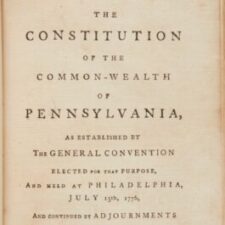 A recent column on the nonprofit news website the Pennsylvania Capital-Star argues that Pennsylvania voters should receive more notice about proposed amendments to the state’s Constitution advanced by Republican lawmakers this year. The column’s author, Patrick Beaty, believes the notice requirements set by the Constitution are insufficient.
A recent column on the nonprofit news website the Pennsylvania Capital-Star argues that Pennsylvania voters should receive more notice about proposed amendments to the state’s Constitution advanced by Republican lawmakers this year. The column’s author, Patrick Beaty, believes the notice requirements set by the Constitution are insufficient.
We have no position on the substance of the amendments or on Beaty’s call for more transparency surrounding the amendment process.
Nevertheless, his column offers an excellent illustration of a major challenge facing the newspaper industry: To reframe the debate around public notice by helping people understand that notices published in newspapers are also published on newspaper websites.
PNRC: Newspapers must post notices on the web
 One of the most important steps newspaper publishers can take to ensure newspapers continue to remain the exclusive vehicle for public notice is to expand the audience for those notices by posting them on their own website and on their state press associations’ statewide public notice website.
One of the most important steps newspaper publishers can take to ensure newspapers continue to remain the exclusive vehicle for public notice is to expand the audience for those notices by posting them on their own website and on their state press associations’ statewide public notice website.
Just ask Nebraska Press Association Executive Director Dennis Derossett, who says that having a statewide website where members can post their notices — and supporting a law requiring them to do so — helped NPA convince lawmakers to increase the rates paid for those notices (see story below).
Public notice eligibility requirements at issue in California and Georgia locales
 Detailed news coverage of the criteria required for newspapers to qualify to publish notices is rare. But last month we found two stories focused largely on that issue. Together they illustrate the policy implications of the choices legislators make when they enact public notice eligibility requirements.
Detailed news coverage of the criteria required for newspapers to qualify to publish notices is rare. But last month we found two stories focused largely on that issue. Together they illustrate the policy implications of the choices legislators make when they enact public notice eligibility requirements.
The first story comes from southeast Georgia, where The Brunswick News reported on the closing of the Waycross Journal-Herald, a 105-year-old daily newspaper that published its last issue on Monday, Sept. 30. Stories about newspapers closing are not uncommon these days. But focusing, as The News did, on the challenge facing public officials in neighboring counties who need to find an alternative “legal organ” is unusual.
Two newspapers that get creative with notice
Print circulation has been declining for years, so newspapers must become creative if they expect to continue to attract eyeballs to their public notice ads.
In Ketchum, Idaho, the Idaho Mountain Express has for many years maintained a pretty simple strategy for drawing attention to their public notices: The 45-year-old newspaper publishes a “Cliff Notes” summary of notices in the news section of its print edition (see graphic below); the summary points readers to the complete, official notices published in its “local life” section. The Mountain Express also publishes the summary in its e-edition along with instructions for where readers can find the official public notices in the print issue and online.
Alert reader helps save a family farm
For some people, reading public notices in the local newspaper is a matter of habit — and sometimes a matter of saving a family farm.
Lindel Foshee gets five newspapers at the home in Red Level, Ala., where she lives with her husband, Booster. She got in the habit of reading public notices during the years they ran the Peoples Bank of Red Level.
Newspaper Notice Helps Save County’s Oldest Grave
 Theophilus Hunter was a big deal in Wake County, North Carolina, and in Raleigh, the county seat. A Revolutionary War leader who owned a popular lodge in the area and held official posts in both the city and county, Hunter is considered a local founding father by some residents. When he died in 1798, he was buried in an area that is now close to the N.C. State University campus.
Theophilus Hunter was a big deal in Wake County, North Carolina, and in Raleigh, the county seat. A Revolutionary War leader who owned a popular lodge in the area and held official posts in both the city and county, Hunter is considered a local founding father by some residents. When he died in 1798, he was buried in an area that is now close to the N.C. State University campus.
It will remain there for now, along with the 17 unmarked graves, as a result of a public notice published in Raleigh’s News & Observer.

